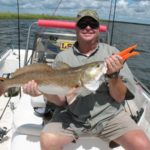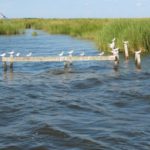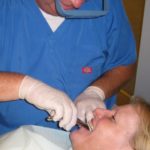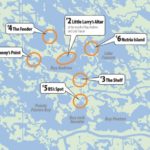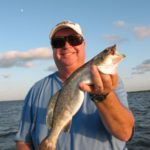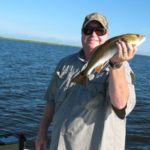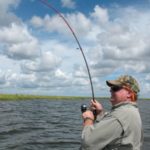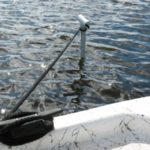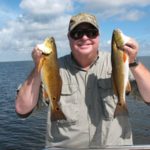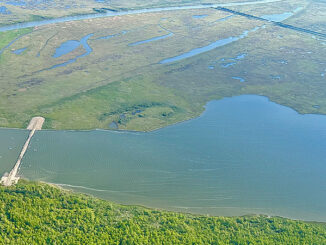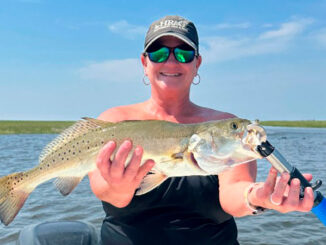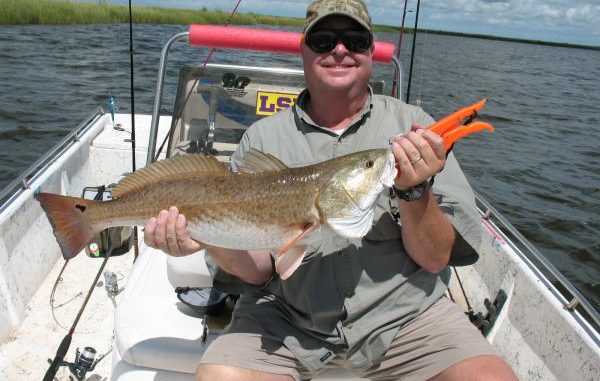
The Doc says to fill your fall trout and redfish prescription out of Delacroix — and he’s mapped out exactly how to do it.
You’ve heard of situations described as “win-win-win.” How about one that’s “Win-Wynn-when?”
The “win” goes in your column if you fill this prescription. The “Wynn” is Kenner dentist Wynn Russo, who will tell you where to go and how to fish it — and the “when” is right now!
It didn’t take long for me to find out my new dentist was an avid fisherman. The copies of Louisiana Sportsman magazine in the waiting room were the first clue. The pictures of people holding up fish were another giveaway, and then when we met for the first time, he clinched it.
“I read all your articles in Louisiana Sportsman magazine,” he said.
But even then I didn’t know just how avid a fisherman he was. But each time I visited I found out more. I discovered that Russo started fishing over 30 years ago, way back before he was a dentist, back in his dental school days when he was introduced to Delacroix’s waters by some long-time Delacroix Island anglers — men like Don McMaster, the late “Ol Man” Bob Badeaux and the late Arthur Loicano, who introduced him to Islanders such as brothers Satch and Thomas Gonzales, who were commercial fishers.
A long-term friendship formed, and the Doc eventually put a camping trailer on Satch’s property at the island to stay in when he fished. I learned that the Doc became quite a fixture down there, and native Islanders would occasionally show up at his door with toothaches and other dental emergencies — which he attended as a courtesy.
And down through the years he often found gifts of seafood left on his doorstep: crabs, shrimp, fish, or sometimes tomatoes or whatever they grew in the garden.
Russo said those islanders accepted him and always made him feel welcome. But they also did something else.
They taught him.
They taught him the places to focus on through the different months of the year, the things to look for and the way to fish various areas successfully. They taught him from their own long experience — old-school style — and to this day he really doesn’t deviate from what he learned.
Which brings me to my story.
Once again, I’m at Doc Russo’s office, and we’re talking about fishing. We always talk about what’s biting and where, and we always say we’re going to get together and make a trip one day. Fishermen always say that to each other. But you know how that is: If you don’t actually stop and put a date on the calendar, that day never comes.
So, I’m in the chair and he’s doing what dentists do when they pick and probe inside your mouth, and again we talked about fishing together. I was serious because I knew the Doc catches fish, plenty fish, and he doesn’t run far to do it.
He fishes every week when possible, often with his sons or grandsons or a few fishing buddies; but he said nowadays he often winds up fishing alone because everybody is too busy.
I figured that was my opportunity to invite myself to fish with him, so I suggested we go that upcoming Sunday afternoon. Everybody else would be huddled around the TV watching the Saints play so we’d have the waters to ourselves, and he could show me where he fishes.
I even promised I’d repay the favor by taking him to some of my spots in Shell Beach.
Sure enough, he bit, and we planned to make that afternoon trip out of Sweetwater Marina in Delacroix Island.
But the Doc warned me that he fished old school.
“Don’t come looking for any fancy whiz-bang gadgets and high-tech equipment,” he said. “I fish out of a small boat, and it’s about as plain and simple as you can get.”
“No problem,” I assured him. “I can do old school. In fact, I like it that way.”
That afternoon I loaded my gear aboard his 18-foot Blue Wave, and the Doc cranked up the 90-horsepower Yamaha two-stroke engine and pointed his bow down Bayou Gentilly.
Doc’s boat. Now keep in mind, I’ve have the privilege of fishing with charter guides and other serious anglers all around southeast Louisiana for over 20 years. I’ve fished on some high-tech and high-dollar rigs with all the latest and most-expensive gadgets. It’s not at all unusual for today’s bay boats to have price tags of $75,000 bucks and up.
And I’ve fished on skiffs with little more than outboard motors.
The Doc’s boat would fall in the latter category: It’s about 10 years old but in good shape, and it was equipped old school style — that is, no GPS, no depth sounder, no trolling motor, no Power-Pole.
Which meant, we’d run and fish the marsh the way the old timers did — by memory.
The Doc ran across Little Lake and then up the Pencil Canal toward our destination: Goose Bay.
“I’m going to show you a half dozen spots you can fish in the fall and catch fish, both trout and redfish,” he said. “It’s one of the first areas I really learned, and it’s been productive for 30 years and will hopefully be productive 30 more years.
“The area we’ll be fishing is called Bay Andrew on the maps, but the locals still call it Goose Bay.”
We turned off the Pencil Canal into a short bayou he called Bulu Bayou, but I couldn’t find that name on any map. He stopped at a grassy point, and I stuck the push-pole down into the soft bottom to hold us there.
While we fished, the Doc shared some of his old-school fishing haunts:
1. Manny’s Point
“This spot is very productive in the fall,” Doc said. “We anchor in the shallow water, but the bottom drops off pretty steep down to 12 to 15 feet. When the tide is moving, the bait flows through here with the current and the fish show up in big numbers to feast on them.
“You can fish it several ways. You can tight-line plastics. I like two (plastics): a chartreuse sparkle beetle on a ¼-ounce jig or a H&H cocohoe in opening night on a ¼- or 1/8-ounce jig. Or you can fish it with a live shrimp on the bottom. I also fish it with the same baits under a popping cork.”
Doc recommended fishing the ledge where the water drops to a deeper depth because the fish hang there, and, given the choice, he prefers this spot on a falling tide although any moving tide will produce.
“You can also throw a gold spoon or live or market shrimp under a cork up against the grass for reds,” he said.
2. Little Larry’s Altar
The old timers called this pass Peppe Compass, but it’s mostly known today as Redfish Pass on the north tip of Bay Andrew.
“Fish this area with live shrimp or sparkle beetles about 2 to 3 feet under a popping cork, or up against the grassy shoreline with gold spoons, or live or market bait under a cork for reds,” the Doc said.
He said this spot gets its name from a wooden framework at a point by the pass. The framework is all that’s left of a platform and an altar of sorts built there by the family of Little Larry Gonzales, who was struck by lightning while fishing out of an aluminum flatboat and died on that spot just a short time before Hurricane Katrina.
“Little Larry was Satch’s grandson, and I still say a prayer for the family every time I pass by it,” he said.
3. The Shelf
This spot is at the mouth of Bay Andrew at the canal from Bay Jack Nevette. The Doc said it drops off to 15 feet deep, and it offers excellent fishing in the fall and winter on both sides of the canal.
“The fish like to line up along that shelf to pounce on the shrimp and baitfish that are moved back and forth through here by the tide,” he said. “A lot of tide flows through here, and the bottom drops out dramatically, from 3 feet down to 15 feet in the length of the boat.
“It really doesn’t matter if the tide is rising or falling, just as long as it’s moving. Fish the shelf with your soft plastics tight-lined, just tossed out and worked slowly back up the ledge toward the boat, or you can fish it with live shrimp the same way.”
4. The Feeder
“We call this spot in Scott’s Pond the Feeder because the pass feeds water and bait to the whole area,” Doc said. “It’s another deep pass, and the fish line up along the ledges waiting for bait to come to them.
“Toss out your soft-plastic beetles or cocohoes, tight-lined, or live bait fished on the ledges. It’s also a good spot to fish a live bait or plastic about 3 feet under a popping cork.
“In my experience, this spot is best either early in the morning or late in the evening, and it will be excellent in the fall.”
5. BS’s Spot
“No, it doesn’t stand for BS, it’s the initials of a good friend who catches fish there consistently,” Doc said. “This spot is at the end of the pipeline canal from Bay Andrew at the mouth of Bay Jack Nevette.
“There’s a point that sticks out just a little into the pipeline canal at Bay Jack, and that’s where we fish. I’ll put my bow right up against the point and throw out into the current.
“The tide moves fast at this spot, and the fish are along the ledges. The water is 12 to 15 feet deep, so you’ll want to fish your plastics tight-lined and just work the bait slowly back toward you, bouncing it up the ledge. We catch a lot of nice trout in there every fall, and it should be turned on right now.”
6. Nutria Island
“The name of this spot might confuse some people because the island is now completely submerged,” Doc said. “But the underwater structure is mostly oyster shells, and it’s still there so it still holds fish.
“This is a pass between Peppe Compass and Lake Fausan, and like most of the other passes in the area it’s between 12 to 15 feet deep. This is not a spot to fish under a cork. Fish the drop-offs with your soft plastics, tight-lined, just worked up the shelf back toward your boat.”
That afternoon the Doc and I fished several of those spots until the dark chased us back to the dock. We used the push pole to test the depth, and when we reached the steep drop-offs we’d stick in the shallows and cast our baits into the deeper water.
We also fished under popping corks at several of the spots, and we caught some nice speckled trout. They weren’t stacked up yet — at least not the way they will be by the time you read this article — but they were beginning to show up and they were hungry.
We fished with live shrimp and plastics, and caught fish on both. Our only regret was we so quickly ran out of daylight before we could even attempt to catch some reds.
We remedied that by heading back early one morning a few days later specifically to chase redfish. The Doc said the very same areas that we fished for trout will hold reds along the grassy shorelines, and this trip proved him right.
Live shrimp under a cork is irresistible to any species of predatory fish along our coast, and reds are no exception. They inhaled them.
But the Doc said they’ll also hit gold spoons, market bait, beetle spins, topwater and subsurface baits throughout the fall.
Now, I suggest you take this prescription down to Delacroix Island and fill it this month. And if anybody wants to know where you’re going, tell them you’re following the doctor’s orders.
DESTINATION INFORMATION
Delacroix Island is about a 45 minute drive from Downtown New Orleans. Take I-10 East from downtown to the I-510 (Paris Road) exit and go south to Chalmette. Turn left on Hwy. 39 and follow it for about 10 miles. When you cross over the Violet overpass, turn left at the blinking light onto the four-lane highway, and follow it for approximately 9 miles until you come to a Four-way stop. Go straight (Hwy 300) after the stop to Delacroix Island.
Marinas
There are several launch sites providing access to the Delacroix area waters.
Serignes has a backdown, fuel, ice, accessories and live and dead bait. Sweetwater Marina has a backdown, ice, dead bait and accessories, and sometimes live bait.
The Reggio Marina (just a couple miles past the Four way stop and a few miles before Delacroix Island) has a backdown ramp.
Maps/Charts
Standard Aerial Photo Map #302; NevaLost Map #8
Guides and accommodations
There are numerous charter guides operating out of these marinas, all of which can provide overnight accommodations. Check the advertisements in this issue for specifics.
